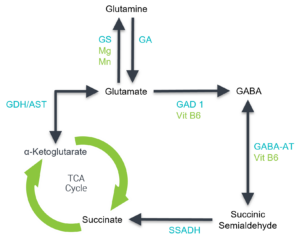GABA is a naturally occurring neurotransmitter known to have a calming effect and is associated with the sleep/wake cycle.2 When we are feeling anxious or hyperactive, it can be a sign of GABA imbalance. GABA imbalance may also cause sleep issues ranging from difficulty sleeping to drowsiness, depending on the degree of imbalance. Testing for GABA levels helps to pinpoint GABA imbalance more specifically to determine how best to correct imbalanced GABA. A diet rich in foods containing GABA, its precursor, and cofactors can be useful to correct low or high GABA levels.
What Does GABA Do?
GABA is an inhibitory neurotransmitter produced in the brain. GABA is also produced and functions in the periphery. As an inhibitory neurotransmitter, GABA blocks excitatory neurotransmitters by decreasing stimulation of nerve cells. This blocking action by GABA leads to the calming effect that GABA is known to produce, which helps reduce anxiousness, regulate sleep, and make us feel calmer.
How Is GABA Made in the Body?
GABA is formed from glutamate with the help of the enzyme GAD (glutamate decarboxylase) and its cofactor, vitamin B6. Although GABA is primarily produced in the central nervous system, specifically the brain, it is also produced in the enteric nervous system, the kidney and the b-cells of the pancreas. Consuming foods that support production of GABA in the body may help increase GABA levels. GABA and its precursor glutamate are also naturally present in a number of food sources such as cruciferous vegetables, beans, peas, spinach, mushrooms, buckwheat, rice and other grains, tomatoes, oolong and white teas.3
 GABA Pathway. GABA is synthesized from glutamate. Upon being metabolized, it can be recycled into glutamate. Enzymes GS: Glutamine Synthetase, GA: Glutaminase, GAD 1: Glutamate Decarboxylase, GABA-AT: GABA Aminotransferase, SSADH: Succinate Semialdehyde Dehydrogenase, GDH: Glutamate dehydrogenase, AST: Aspartate transaminase Cofactors Mg: Magnesium, Mn: Magnanese, Vit: Vitamin
GABA Pathway. GABA is synthesized from glutamate. Upon being metabolized, it can be recycled into glutamate. Enzymes GS: Glutamine Synthetase, GA: Glutaminase, GAD 1: Glutamate Decarboxylase, GABA-AT: GABA Aminotransferase, SSADH: Succinate Semialdehyde Dehydrogenase, GDH: Glutamate dehydrogenase, AST: Aspartate transaminase Cofactors Mg: Magnesium, Mn: Magnanese, Vit: Vitamin
How Does GABA Affect the Brain?
GABA helps you feel calmer by decreasing nerve cell stimulation in the brain, which blocks excitatory neurotransmitters. This activity of GABA leads to calming effects. Therefore, having sufficient levels of GABA helps with4,5
- Calm and relaxation
- Mood
- Regulation of excitability
- Sleep regulation
What Happens When You Have a GABA Imbalance?
Imbalanced GABA levels are associated with a number of health concerns that impact quality of life. For example:
- Mental and Emotional Health
- Low GABA symptoms include anxiousness, sad feelings, and mood swings.6
- High GABA symptoms include poor cognition/difficulty concentrating and difficulties with memory.
- Sleep Disruptions
- Poor sleep, including difficulty falling and staying asleep, is linked to GABA deficiency.5
What Happens When You Have Too Much GABA?
GABA may be synonymous with getting a good night’s sleep and is sometimes taken to optimize sleep. However, excess GABA can cause drowsiness and daytime sleepiness.7 In instances when GABA is being considered as a supplement, testing for GABA levels may be helpful to determine how much GABA should you take. Tailoring supplementation of GABA to an individual’s test results can help to avoid excessive supplementation and high GABA symptoms.
How Does GABA Become Imbalanced?
A number of factors can disrupt GABA levels or associated hormones and neurotransmitters. These factors include:
- Alcohol consumption. Over time alcohol intake can cause down-regulation of GABA receptors, resulting in low GABA levels.8
- Poor diet or maldigestion. The nutrients and cofactors found in foods necessary to make GABA can affect GABA levels. 3 Therefore, a poor diet can potentially cause low GABA levels. Some people can eat a healthy diet but due to maldigestion or malabsorption, they may still have low GABA.
- Stress. Over time stress can cause elevated levels of epinephrine, norepinephrine, and dopamine. As GABA rises to inhibit the effect of these catecholamines, it can become depleted.9
How Does GABA Interact with Other Hormones and Neurotransmitters?
GABA works in conjunction with other neurotransmitters, most notably serotonin. As inhibitory neurotransmitters, GABA and serotonin should both be present in adequate levels to ensure that each can carry out their inhibitory effects in the body. When serotonin levels are low, GABA may compensate to ensure that inhibitory effects continue; this can ultimately lead to low GABA levels. Insufficient levels of GABA or serotonin would further impact the ability to counteract excitatory neurotransmitters such as glutamate, epinephrine, and norepinephrine.
Additionally, elevated glutamate may be an indicator of low GABA and underlying cofactor deficiencies. GABA also interacts with hormones in the body. Dehydroepiandrosterone (DHEA) blocks GABA, which can result in increased levels of glutamate. Progesterone’s metabolite allopregnanolone increases GABA activity while excessive GABA inhibits thyroid function.
How to Test GABA Levels
Testing neurotransmitters is the ideal way to test GABA levels. NeuroLab® is a premier laboratory for testing neurotransmitters and hormones, including GABA. NeuroLab® uses the gold standard in urinary neurotransmitter testing, UHPLC Triple Quadrupole Mass Spectrometry, providing the highest level of sensitivity and specificity for analyzing neurotransmitters. It is used around the world at major universities and research facilities. 10-14
NeuroLab® offers convenient urine neurotransmitter testing to help identify neurotransmitter imbalances, including GABA. A simple GABA urine test can help identify GABA imbalance in patients who are in need of calming and sleep support. This simple test allows patients to test GABA levels at home, without visiting a physician’s office or clinic.
How Can We Naturally Support GABA?
It is possible to encourage healthy levels of GABA through lifestyle measures, including:
- Consuming foods that contain GABA, or support its production, may help increase GABA levels. As mentioned above, high GABA foods include:3
- Brown rice
- Cruciferous vegetables (Brussels sprouts, broccoli, cauliflower, cabbage)
- Mushrooms
- Spinach
- Sprouted grains
- Sweet potatoes
- Tomatoes
- Dietary supplements containing ingredients that support GABA receptors can reduce symptoms associated with imbalanced GABA. These supplements can also support the inhibitory properties of GABA and symptoms associated with low GABA:15-18
- L-Theanine*
- Magnesium*
- Taurine*
- Patients can take GABA in a supplement form to improve GABA levels.* Vitamin B6 is also an important cofactor in the production of GABA from glutamic acid.
- Exercise, such as high-intensity exercise, can also increase GABA levels.19
References
- Ranjbar-Slamloo Y, Fazlali Z. Front Mol Neurosci. 2019;12:334.
- Halson SL. Sports Med. 2014;44 Suppl 1(Suppl 1):S13-23.
- Briguglio M, Dell’Osso B, et al. Nutrients. 2018;10(5).
- Ngo DH, Vo TS. Molecules. 2019;24(15).
- Bruni O, Ferini-Strambi L, et al. Nutrients. 2021;13(2).
- Duman RS, Sanacora G, et al. Neuron. 2019;102(1):75-90.
- StatPearls Publishing. Published 2022. https://www.ncbi.nlm.nih.gov/books/NBK551683/.
- Koob GF, Colrain IM. Neuropsychopharmacology. 2020;45(1):141-165.
- Chaves T, Fazekas CL, et al. Int J Mol Sci. 2021;22(16).
- Barthelemy C, Bruneau N, et al. J Autism Dev Disord. 1988;18(4):583-591.
- Llorente AM, Voigt RG, et al. Clin Neuropsychol. 2006;20(1):133-144.
- Nichkova MI, Huisman H, et al. Anal Bioanal Chem. 2012;402(4):1593-1600.
- Grossman F, Potter WZ. Psychiatry Res. 1999;87(1):21-27.
- Linnoila M, Miller TL, et al. Arch Gen Psychiatry. 1984;41(7):688-692.
- Eschenauer G, Sweet BV. Am J Health Syst Pharm. 2006;63(1):26, 28-30.
- Kakuda T, Nozawa A, et al. Biosci Biotechnol Biochem. 2002;66(12):2683-2686.
- Jia F, Yue M, et al. J Neurosci. 2008;28(1):106-115.
- Held K, Antonijevic IA, et al. Pharmacopsychiatry. 2002;35(4):135-143.
- Coxon JP, Cash RFH, et al. J Physiol. 2018;596(4):691-702.


